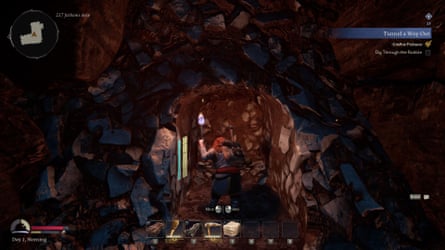The elves have exited on ships bound for the west, humans are at the top of the pecking order across Middle-earth, and the dwarves are taking the opportunity to retake their greatest city, Khazad-dûm: this survival game picks up after the defeat of Sauron, in the Fourth Age of Tolkien’s world. Overrun by orcs and once ruled by a fiery Balrog, the loss of the mines of Moria remains a sticking point for our gold-loving excavators. You step into the steel toe-capped boots of a dwarf in the first expedition into the mines since the Fellowship carved a path through its dark tunnels and Gandalf met the long end of the Balrog’s whip of fire.
The start of your own adventure doesn’t go much better, as a barrel of TNT causes a cave-in that leaves you trapped in the city under the soil with no way of bringing in aid from outside. You must replicate the Fellowship’s journey and head west through the mines to find an exit. Sauron may be gone, but the orcs of Moria haven’t got the message. Facing a mine teeming with green-skins, you must set about crafting the weapons, armour, and pickaxes you need to survive.
At first, these are little more than bits of rock strapped to scraps of stick, but as you go deeper into Khazad-dûm, repairing old dwarven statues as you go, you learn the recipes for more powerful gear: First Age longswords, Elven spears, a hat with a candle stuck on top. You do the bulk of your crafting, cooking, smelting and arrow-fletching at your camp – something you can build anywhere in the mines simply by placing down a hearth and a bedroll. Your camps are your home and your factory, where you can rest and build.
The mines are procedurally generated, so no two games will have the exact same layout of rooms. However, the sequence of environments you explore does repeat. You’ll start your adventure near the surface, in dark tunnels that only have veins of iron ore, stone, and coal, before you break through into an underground glade, where you can find Elven wood and a forge hot enough to make the steel you need for a stronger pickaxe. Armed with upgraded tools, you can dig into Moria proper and discover gemstones, copper, and mithril veins. As you discover new resources, you unlock new blueprints and recipes, allowing for more advanced facilities that let you create better gear.
This is very much the order of service for the entire game. You carve a path into a new area, and are immediately faced with a barrier that prevents progression until you’re armed with upgraded stuff. It’s hardly the first game to pace your journey in this way, but it would be less noticeable if your moment-to-moment actions were more enjoyable. Combat is simplistic; enemies march up to you with their weapons held high, and you wildly swing at them with whatever you have to hand until they’re all dead. Some, like the spiders in Moria, will spit poison from a distance, but it’s easy to close the gap and splat them with a hammer. Enemies get tougher in each new area, so you’re always either underpowered in a new environment or killing things in three hits. The enemies may change, but the battles don’t.

Crafting, too, becomes repetitive. As the facilities you build aren’t shared across your camps, you either build costly advanced facilities, such as bellows and gem cutters, in each camp, or you have to walk all of your loot back to your most developed base whenever you wish to do any crafting. Until you eventually unlock fast travel – making it easier to hop between your camps – for many hours, your only way to travel through Khazad-dûm is by walking back and forth through its gloomy, samey tunnels.
There are moments when The Lord of the Rings: Return to Moria hints at what it could have been, such as when you’re mining a rich vein of ore in some dark tunnel, and your dwarf becomes inspired to sing. They’ll clear their throat and give voice to a story of trolls and orcs and the beating that will rain down on them if they cross your path. The game briefly feels alive, the story making the cold mines warm. But then the song stops, and you’re still mining, and all you have to look forward to is a long walk back to the forge.
-
The Lord of the Rings: Return to Moria is out now on PC, 4 December on PS5, and early 2024 on Xbox; £31.69

